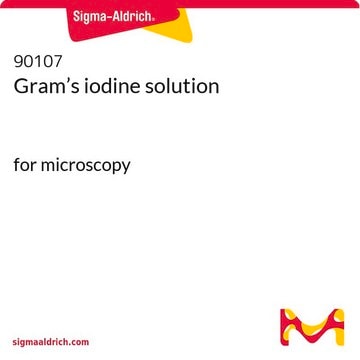15713
Universal Food pathogen ID Membrane
light pink colored, sterile, diameter 70 mm, suitable for microbiology
Synonym(s):
Indicator membrane, ID Membranes
Sign Into View Organizational & Contract Pricing
All Photos(1)
About This Item
UNSPSC Code:
41171621
NACRES:
NA.85
Recommended Products
membrane size
70 mm
sterility
sterile
shelf life
limited shelf life, expiry date on the label
storage condition
protect from light
technique(s)
microbe id | specific enzyme detection: suitable
application(s)
food and beverages
microbiology
storage temp.
2-8°C
suitability
Bacillus spp.
Escherichia coli
Listeria spp.
Salmonella spp.
Shigella spp.
Staphylococcus spp.
coliforms
enterovirulent E. coli (EEC)
General description
Universal Food pathogen ID Membranes are substrate-carrying membranes used for rapid identification and differentiation of food pathogens through characteristic color reactions by placing on the agar surface post-incubation. The membranes contain chromogenic substrates such as ONPG, X-Gal, or X-Glu, and other substrates and indicators, which serve as the basis for microbe differentiation by color. The target organisms possess enzyme systems that metabolize the substrates in the membrane, leading to a change of color. The colors can be visually detected on the membrane. This indicates microbial enzymatic activity which serves to identify the genus and species. This economical, confirmatory and rapid identification method is suitable for microorganisms from various food, dairy, fish, and meat products.
Application
Universal Food pathogen ID Membrane is recommended for detection of food pathogens such as E. coli, E. coli O157:H7, Staphylococcus aureus, Salmonella, Bacillus, Listeria, and Shigella species, etc. from various food, dairy, fish, and meat products. They find their application in various sectors such as the water, food, and dairy industry.
Analysis Note
Escherichia coli (25922)purpleStaphylococcus aureus (25923)golden yellowSalmonella Typhimurium (14028)colorlessBacillus cereus (10876)light green (big)Listeria monoyctogenes (19111)blue- greenEscherichia coli O157:H7 (NCTC 12900)purple pinkShigella flexneri (12022)colorless
Storage Class
11 - Combustible Solids
wgk_germany
WGK 3
flash_point_f
Not applicable
flash_point_c
Not applicable
Choose from one of the most recent versions:
Already Own This Product?
Find documentation for the products that you have recently purchased in the Document Library.
Peng Wang et al.
Current biology : CB, 27(21), 3278-3287 (2017-10-24)
The C
Johannes H Wilbertz et al.
Molecular cell, 73(5), 946-958 (2019-01-22)
Biological phase transitions form membrane-less organelles that generate distinct cellular environments. How molecules are partitioned between these compartments and the surrounding cellular space and the functional consequence of this localization is not well understood. Here, we report the localization of
David Deutsch et al.
eLife, 9 (2020-11-24)
Sustained changes in mood or action require persistent changes in neural activity, but it has been difficult to identify the neural circuit mechanisms that underlie persistent activity and contribute to long-lasting changes in behavior. Here, we show that a subset
Sofia Moreira et al.
Cell reports, 26(2), 293-301 (2019-01-10)
Apical-basal polarity is a common trait that underlies epithelial function. Although the asymmetric distribution of cortical polarity proteins works in a functioning equilibrium, it also retains plasticity to accommodate cell division, during which the basolateral determinant Lgl is released from
Lukas N Groschner et al.
Cell, 173(4), 894-905 (2018-05-01)
Perceptual decisions require the accumulation of sensory information to a response criterion. Most accounts of how the brain performs this process of temporal integration have focused on evolving patterns of spiking activity. We report that subthreshold changes in membrane voltage
Our team of scientists has experience in all areas of research including Life Science, Material Science, Chemical Synthesis, Chromatography, Analytical and many others.
Contact Technical Service







